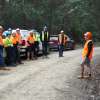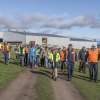
Carbon methods for native forests must be ‘nature positive’
Posted 30 October 2024
Forestry Australia is calling on the Australian Government to ensure that new ACCU Scheme carbon methods developed for managing native forests are truly ‘nature positive’, of high integrity and robustness, and will support the long-term health and resilience of our native forests and communities.
Acting President, Dr Bill Jackson said Forestry Australia acknowledges the Australian Government has this week announced a short list of new carbon methods for the ACCU Scheme.
“Forestry Australia submitted a strong carbon method proposal for consideration under the Proponent-Led Method Development Process for the ACCU Scheme.
“At this stage, the Forestry Australia-led proposal has not been prioritised; however, we are very encouraged by the advice from the Emissions Reduction Assurance Committee that our proposal has excellent alignment with the Offsets Integrity Standards and triage criteria and supported it for development, if or when departmental resources permit,” Dr Jackson said.
“Forestry Australia remains fully supportive of its proposed new carbon method and is looking forward to engaging with the Australian Government to progress its further development in the near future. Forestry Australia calls on the Australian Government to commit more resources to the ACCU Scheme and its proponent-led method development process.”
“The proposed method, Enhancing Native Forest Resilience, is focussed on improving the health and resilience of native forests and encouraging active, adaptive management of native forests across all land tenures to assist Australia in meeting its Paris Agreement targets.
“Our proposed method is also based on enabling broader participation in the carbon market, which could include State forest management agencies and national parks managers as well as community groups, not-for-profits, private native forest landowners, and First Peoples.
“Forestry Australia’s method is based on a growing body of published work that shows forests that are actively managed can have greater carbon sequestration and storage potential.
“The proposal encompasses restorative forestry practices and active forest management focused on improving habitat values, carbon stocks and resilience to droughts and wildfires.
Media release | October 30, 2024
Share this Article
Latest Articles
-

17 September 2025
Celebrating excellence at the Tasmanian Timber Awards
-

17 September 2025
Forest Practices Authority Research Update Day
-

13 August 2025
Have you seen our Stems for CO2 Project signage on the Midlands Highway?
Archives
- ActivAcre hits milestone, calls for more farmers to get on board
- Napier's leading the way in sustainable forestry and carbon-neutral farming
- Sound science needed to assess carbon impacts of timber harvesting
- Newly appointed TFFPN Board of Directors
- Graduate Certificate of Forestry Scholarship
- Forestry Australia Mentoring Program 2025
- Forest Industry Roundtable planning for the long term
- Eagle Management Constraint Period extended
- Successful private native forest management celebrated
- $15 million investment in new ship loader to boost Bell Bay's forestry exports
- Standing with Tasmania's forestry industry: buy local
- TFPA: Tasmanian Freight Equalisation Scheme needs a ground-up review
- AFCA Gala Dinner celebrates industry excellence
- Fire permits now required Statewide
- Forest leaders hone skills in sustainable native regrowth management
- Tasmanian forests and the carbon market: Barriers and opportunities
- Spring is the time for fuel reduction burning
- Primed for Growth: A situation analysis of the Tasmanian Forest and Wood Products Sector
- Audit requirements cut for low-risk plantation projects
- Guidance and support for landowners after damaging winds
- Forestry Australia welcomes further definition of active forest management
- Farm & Forest Mapper Tool highlighted at Rural Youth Tasmania's Young Farmer of the Year competition
- Senate Select Committee inquiry into the Tasmanian Freight Equalisation Scheme
- Timberlink announces new wood composite products brand
- Newly developed protocol a vital tool for safeguarding forestry industry
- Red Hot Tips: Fire management for Tassie farmers
- Bioenergy: Fuelling industries with trees
- Harvesting trees: What you need to know
- Shelterbelts: How are they contributing to farm systems?
- Infill plantings and remnant vegetation: Why biodiversity depends on a thriving understory
- Plantation planning: The key to a successful plantation
- Exciting interactive forestry knowledge hub launched
- $450,000 farm forestry grant recipients revealed



